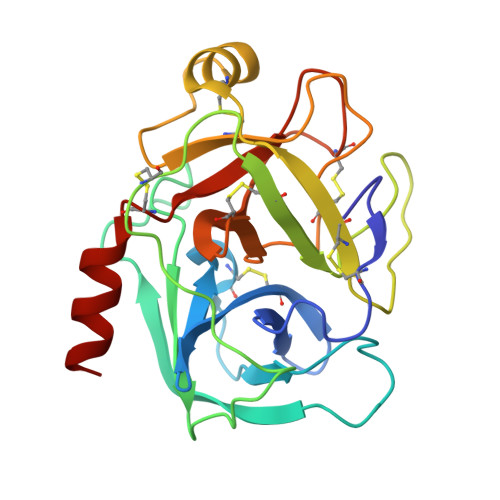Structural basis for the design of novel Schiff base metal chelate inhibitors of trypsin
Iyaguchi, D., Kawano, S., Takada, K., Toyota, E.(2010) Bioorg Med Chem 18: 2076-2080
- PubMed: 20202854
- DOI: https://doi.org/10.1016/j.bmc.2010.02.016
- Primary Citation of Related Structures:
3AAS, 3AAU, 3AAV - PubMed Abstract:
The crystal structures of the complexes of bovine trypsin with m-guanidinosalicylidene-l-alaninato(aqua)copper(II) hydrochloride (inhibitor 1), [N,N'-bis(m-guanidinosalicylidene)ethylenediaminato]copper(II) (inhibitor 2), and [N,N'-bis(m-amidinosalicylidene)ethylenediaminato]copper(II) (inhibitor 4) have been determined. The guanidine-containing trypsin-inhibitors (1 and 2) bind to the trypsin active site in a manner similar to that previously reported for amidine-containing inhibitors, for example, m-amidinosalicylidene-l-alaninato(aqua)copper(II) hydrochloride (inhibitor 3). However, the binding mode of the guanidino groups of inhibitors 1 and 2 to Asp189 in the S1 pocket of trypsin was found to be markedly different from that of the amidino group of inhibitor 3. The present X-ray analyses revealed that the interactions of the metal ion of the inhibitors with the active site residues of trypsin play a crucial role in the binding affinity to the trypsin molecule. These structural information and inhibitory activity data for amidine- and guanidine-containing Schiff base metal chelate inhibitors provide new avenues for designing novel inhibitors against physiologically important trypsin-like serine proteases.
Organizational Affiliation:
Faculty of Pharmaceutical Sciences, Health Sciences University of Hokkaido, Ishikari-Tobetsu, Hokkaido 061-0293, Japan.

















